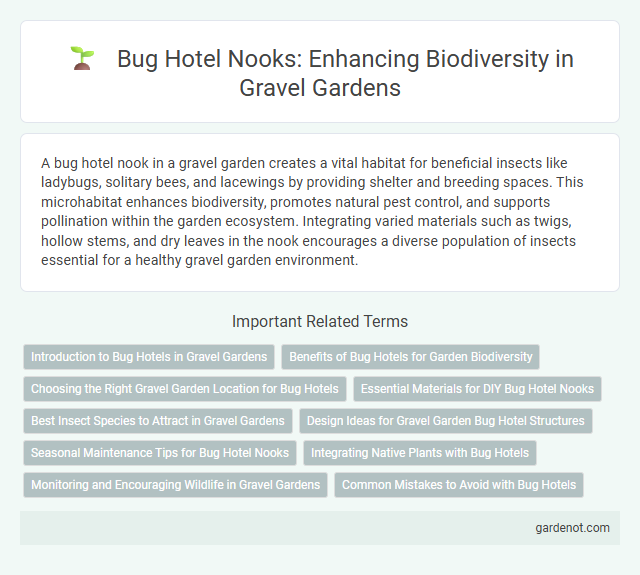A bug hotel nook in a gravel garden creates a vital habitat for beneficial insects like ladybugs, solitary bees, and lacewings by providing shelter and breeding spaces. This microhabitat enhances biodiversity, promotes natural pest control, and supports pollination within the garden ecosystem. Integrating varied materials such as twigs, hollow stems, and dry leaves in the nook encourages a diverse population of insects essential for a healthy gravel garden environment.
Introduction to Bug Hotels in Gravel Gardens
Bug hotels in gravel gardens provide essential habitats for beneficial insects such as ladybugs, solitary bees, and beetles, promoting biodiversity and natural pest control. Constructed using natural materials like wood, bamboo, and stones, these niches mimic insects' preferred environments and encourage pollination. Integrating bug hotels into gravel garden designs enhances ecological balance while supporting sustainable gardening practices.
Benefits of Bug Hotels for Garden Biodiversity
Bug hotels provide essential habitats for beneficial insects such as ladybugs, solitary bees, and lacewings, which contribute to natural pest control and pollination. These structures enhance garden biodiversity by supporting a variety of species that improve soil health and plant growth. Incorporating bug hotels into a gravel garden promotes ecological balance and strengthens the resilience of the garden ecosystem.
Choosing the Right Gravel Garden Location for Bug Hotels
Selecting the ideal gravel garden location for a bug hotel involves choosing a sunny, sheltered spot that mimics natural habitats and offers protection from harsh weather. Positioning near flowering plants and shrubs enhances biodiversity by attracting pollinators like bees and butterflies. Ensuring well-drained soil prevents moisture buildup, creating a stable environment for beneficial insects to thrive.
Essential Materials for DIY Bug Hotel Nooks
Essential materials for DIY bug hotel nooks include untreated wood, bamboo canes, dry leaves, straw, pine cones, and hollow stems to attract diverse beneficial insects. Incorporating bricks with holes, terracotta pots, and corrugated cardboard provides shelter and breeding sites for pollinators and predatory bugs. Ensuring materials are free from chemicals and positioned in a sheltered, sunlit part of a gravel garden maximizes habitat effectiveness.
Best Insect Species to Attract in Gravel Gardens
Ladybugs, mason bees, and lacewings are some of the best insect species to attract in gravel gardens, as they contribute to natural pest control and pollination. Creating bug hotel nooks with varied materials like hollow stems and small logs provides shelter and breeding sites for these beneficial insects. Encouraging diverse insect populations supports plant health and enhances the ecological balance in gravel garden ecosystems.
Design Ideas for Gravel Garden Bug Hotel Structures
Design ideas for gravel garden bug hotel structures include using varied natural materials such as hollow bamboo canes, stacked stones, and pine cones to create diverse habitats for beneficial insects. Incorporating compact, small compartments within a wooden frame helps attract solitary bees, ladybugs, and lacewings by mimicking their preferred nesting environments. Positioning the bug hotel in a sunny, sheltered area with proximity to flowering plants enhances insect activity and supports garden biodiversity.
Seasonal Maintenance Tips for Bug Hotel Nooks
Seasonal maintenance of bug hotel nooks involves removing debris and checking for moisture buildup to prevent mold and ensure a safe habitat for beneficial insects. Replenishing natural materials like twigs, leaves, and hollow stems each spring enhances shelter quality and promotes insect biodiversity. Regular inspections during autumn help prepare the nook for overwintering insects by securing loose components and clearing away fallen leaves.
Integrating Native Plants with Bug Hotels
Integrating native plants with bug hotels enhances biodiversity by providing essential habitats and food sources for beneficial insects such as solitary bees, ladybugs, and lacewings. Native flora supports local ecosystems and improves pollination, while the bug hotel offers shelter and breeding sites, promoting a balanced garden environment. This synergy creates a resilient gravel garden that sustains pest control and encourages natural ecological interactions.
Monitoring and Encouraging Wildlife in Gravel Gardens
A bug hotel nook within a gravel garden provides essential habitats for beneficial insects like ladybugs, solitary bees, and predatory beetles, enhancing biodiversity and pest control. Regular monitoring through visual inspections and wildlife cameras helps track species presence and diversity, ensuring the bug hotel supports local ecosystems effectively. Encouraging wildlife is achieved by maintaining a variety of plant species, avoiding pesticides, and providing sheltered microhabitats that promote insect reproduction and shelter.
Common Mistakes to Avoid with Bug Hotels
Placing bug hotels in shaded, damp areas often leads to mold growth and deters beneficial insects from nesting. Using treated wood or synthetic materials can release harmful chemicals, negatively impacting biodiversity. Avoid overcrowding compartments to ensure proper habitation and maintain healthy insect populations in your gravel garden.
Bug hotel nook Infographic

 gardenot.com
gardenot.com